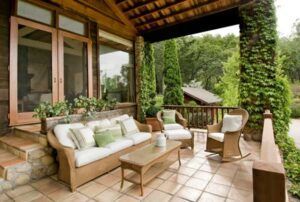Apply Zen Garden Principles to Your Deck Design
Who doesn’t need a little more Zen in their lives? Zen gardening has made its way to the United States in part because of the peaceful ambiance it creates. Perhaps you don’t have the space to dedicate to a backyard Zen garden, though. Instead, you can apply the principles of the style to your deck, which is an ideal space for a peaceful retreat.
Start With Wood or Composite Decking
One of the principal materials used in Japanese landscaping is wood. Even within a Zen garden, you’ll often find platforms of wooden decking, so choosing this material for your Zen-inspired deck makes sense. Redwood and cedar are two of the most common hardwoods for deck construction, though Douglas fir, cypress, and pine are also popular.
If you want the look of wood without the maintenance, consider composite decking. Manufacturers mix wood scraps with plastic and form planks that look like solid wood. They also treat the planks with preservatives that make them impervious to rot, mildew, and mold. Between the incorporation of plaster and the preservatives, composite decking requires less maintenance than solid wood.
Incorporate Natural Stone
Rock gardens are a centerpiece of Japanese landscaping. If you can dedicate a corner of your deck to a rock garden, that would be ideal. You only need a small space with some gravel, a decorative rock, and an odd number of plants. Those are the basic elements of a Zen garden.
Concerning the deck itself, consider incorporating natural stone elsewhere as well. You might include a stone bench, firepit, or water fountain as part of your design. You can also choose stone for part of the decking itself, like for the railing posts.
Encourage a Meandering Path
Japanese gardening principles favor meandering paths over straight lines because it’s thought such paths discourage evil spirits from entering your home. This principle is the reason you sometimes see meditation paths incorporated into a Zen garden.
Try applying this principle to your deck layout without hindering its utility. You might accomplish this principle with a selection of smaller decks that make up the larger deck. This principle would be well-served with tiers of decks on a sloped yard.
You can also achieve the ideal with well-placed deck features. So, you could interrupt the straight line with a grilling station in one space, a firepit in another, and a water fountain in yet another. The goal is to create a clear path, but one that naturally winds around these features.
Include a Water Feature
Speaking of water fountains, water is another important element of Japanese landscaping. The water symbolizes purification and cleansing. However, running water also creates a pleasing sound, which speaks to the sensory nature of Zen gardening.
As described above, a built-in or standalone water fountain would be a good installation for your Zen deck. Still pools and koi ponds are also common. If you have the space available, consider incorporating one of those features as a focal point.
You can also use water as a transitional feature. For instance, you might have a decorative pond as part of your landscaping. Consider having a waterfall off the edge of the deck, which would provide a strong connection to the Zen principles.
Pay Attention to the View
In that vein, you likely want the view from your deck to be inspirational. After all, part of the rationale for creating a Zen garden is to create that feeling of Zen. When you sit on your Zen-inspired deck, you likely want to look out over a pleasing vista.
The principles of such landscaping call for creating a view that encourages contemplation. To that end, designers often pair the ephemeral with the permanent, say with an ornamental tree next to an ornamental boulder. They also pair the vertical with the horizontal, perhaps with a tall statue in the curve of a walkway.
Give your new deck a unique spin by utilizing the principles of Zen landscaping in its design. Let D.S. Bahr Construction, Inc. , help design and build your new deck.
The post Apply Zen Garden Principles to Your Deck Design appeared first on D.S. Bahr Constraction, Inc.













